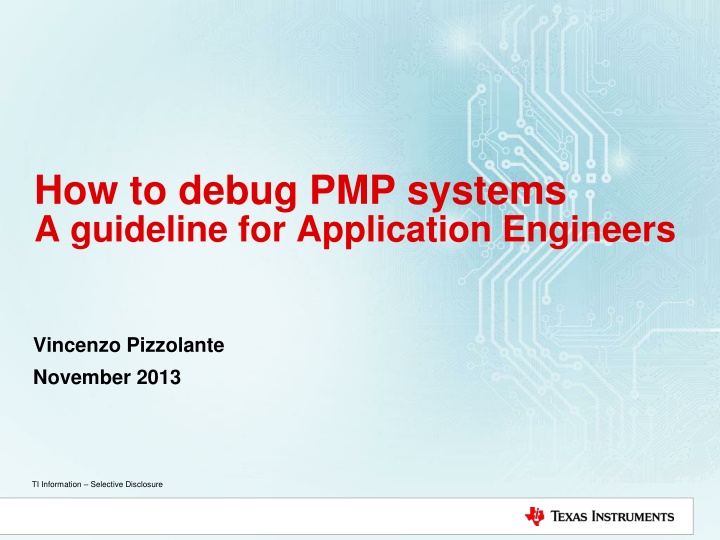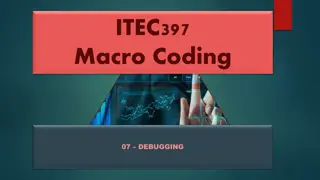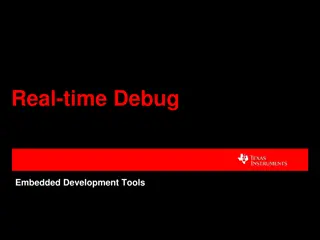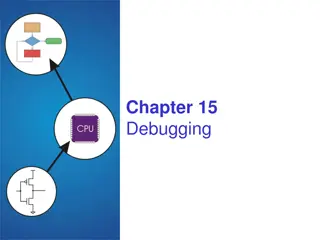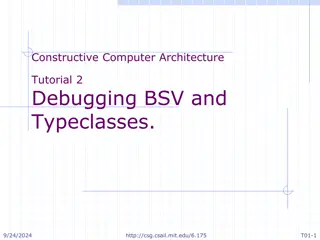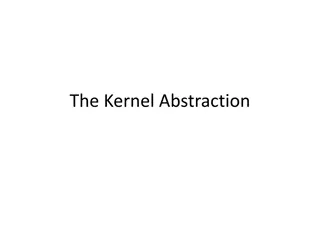Debugging PMP Systems: A Guideline for Application Engineers
Comprehensive guideline by Vincenzo Pizzolante on debugging PMP systems for application engineers, covering topics like analysis, technical aspects, layout guidelines, trace inductance, case studies, and dealing with noise generators. Includes real-life examples and actionable solutions for managing power management layouts effectively.
Download Presentation

Please find below an Image/Link to download the presentation.
The content on the website is provided AS IS for your information and personal use only. It may not be sold, licensed, or shared on other websites without obtaining consent from the author.If you encounter any issues during the download, it is possible that the publisher has removed the file from their server.
You are allowed to download the files provided on this website for personal or commercial use, subject to the condition that they are used lawfully. All files are the property of their respective owners.
The content on the website is provided AS IS for your information and personal use only. It may not be sold, licensed, or shared on other websites without obtaining consent from the author.
E N D
Presentation Transcript
How to debug PMP systems A guideline for Application Engineers Vincenzo Pizzolante November 2013 TI Information Selective Disclosure TI Information Selective Disclosure
Agenda Section I The path of the analysis Section II The technical aspects Section III When guilty is the layout TI Information Selective Disclosure
Layout guidelines for the Power Management The origins of the noise Reccomended layout per topology Real life example Reccomended layers stack-up Land patterns of power components TI Information Selective Disclosure
Layout guidelines for the Power Management The origins of the noise Reccomended layout per topology Real life example Reccomended layers stack-up Land patterns of power components TI Information Selective Disclosure
Trace Inductance Typical 10mils trace
Case Study: Ideal World Is Is current source Vc Vc
Case Study: Non Ideal World stray inductance (PCB traces) Is Is current source Vc Vc
Case Study: Non Ideal World High di/dt Is Is current source Vc Vcg Vcg Vc High di/dt causes noise accross stray inductance! High EMI
Impact of High di/dt VIN All elements, including PCB traces, have parasitic L, R, C High di/dt thru parasitic L produces voltage spikes Vout Must avoid injecting these currents into the ground plane First, identify high di/dt paths
How to Deal with the Noise Generators VIN Note the re-route of the diode-return path Forces pulse currents directly back to input cap Keeps high di/dt currents out of ground Diode anode may actually be a bit noisier, but who cares? Can apply the same rationale to all topologies Vout
Layout guidelines for the Power Management The origins of the noise Reccomended layout per topology Real life example Reccomended layers stack-up Land patterns of power components TI Information Selective Disclosure
Locating the high di/dt paths Buck Boost Sepic
Buck: High di/dt Paths Draw the switch-ON current path in one color Then draw the switch-OFF path in another Any part of the circuit that has only a single color, or both with current arrows in opposite direction, is a high di/dt path Works for all topologies! High di/dt
Buck: High di/dt Paths Identified #1 Most important paths! Keep this GND path separated from the GND plane!
Layout guidelines for the Power Management The origins of the noise Reccomended layout per topology Real life example Reccomended layers stack-up Land patterns of power components TI Information Selective Disclosure
Example with Lab Results This is the schematic of an actual LM3100 demo board
VO (AC) With Improper Layout 250MHz Bandwidth, 100mV/div 20MHz Bandwidth, 100mV/div
Improper Layout Artwork LM3100 Rev. B - Problem layout: Top Silk Bottom copper Top copper
Recall Buck di/dt Paths #1 Most important paths! Keep this GND path separated from the GND plane!
Improper Layout Artwork - The Critical Paths - Red = Bottom Blue = Top
Improved Layout Artwork LM3100 Rev. C - Proper layout: Top Silk Top copper Bottom copper
Improper Layout Artwork - The Critical Paths - Red = Bottom Blue = Top
VO (AC) With Improper Layout (Rev. B) 250MHz Bandwidth, 100mV/div 20MHz Bandwidth, 100mV/div
VO (AC) Improved Layout (Rev. C) 250MHz Bandwidth, 20mV/div 20MHz Bandwidth, 20mV/div
Improved Layout Effects 20MHz Bandwidth, 100mV/div (Rev. B) 20MHz Bandwidth, 20mV/div (Rev. C)
Layout guidelines for the Power Management The origins of the noise Reccomended layout per topology Real life example Reccomended layers stack-up Land patterns of power components TI Information Selective Disclosure
4-Layers PCB Desired Undesired Layer 1 Power components Layer 2 GND plane Layer 3 Small signal Layer 4 Small signal / controller Layer 1 Power components Layer 2 Small signal Layer 3 GND plane Layer 4 Small signal / controller GND plane separate the small signal and forms a mechanical bulk cap with the Power layer Switching currents from power components to GND plane cause capacitive cross-talk to the small signal TI Information Selective Disclosure
6-Layers PCB Desired Undesired Layer 1 Power components Layer 2 GND plane Layer 3 Small signal Layer 4 Small signal Layer 5 DC power / GND plane Layer 6 Power components / controller Layer 1 Power components Layer 2 Small signal Layer 3 GND plane Layer 4 DC power / GND plane Layer 5 Small signal Layer 6 Power components / controller DC power and GND planes work as reference planes in AC In a multilayers PCB the GND plane should not be fragmented TI Information Selective Disclosure
Layout guidelines for the Power Management The origins of the noise Reccomended layout per topology Real life example Reccomended layers stack-up Land patterns of power components TI Information Selective Disclosure
Land patterns of power components TI Information Selective Disclosure
Connecting Bypass Capacitors Connecting to high frequency bypass caps: This assumes a connection into internal planes Terrible! Long thin traces add inductance and effectively isolate the capacitor Good Keeping vias close to pads minimizes parasitic inductance Better Doubled vias further reduce inductance Best This technique further reduces inductance by reducing the high frequency loop area Super!
Connecting Bypass Capacitors TERRIBLE GOOD
Thank You! Questions? TI Information Selective Disclosure TI Information Selective Disclosure
